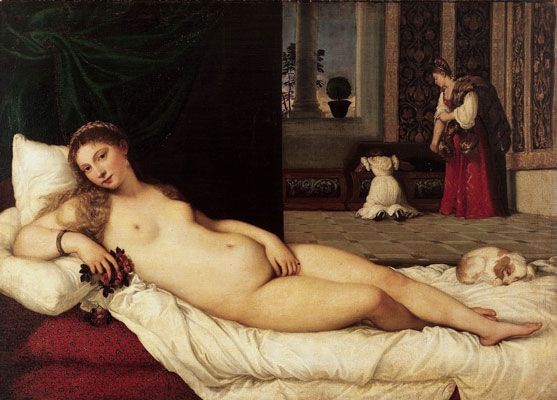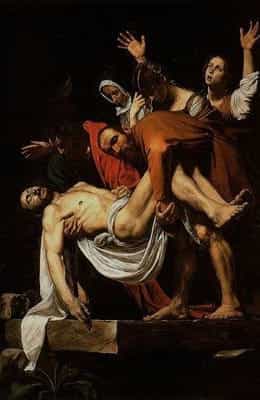Summary of Peter Paul Rubens
Peter Paul Rubens epitomized the "gentleman" artist archetype. Productive, professional, and moving with ease amongst both artistic and political circles, he exemplified what it meant to be a proper courtly painter of the 17th century, elevating his own life to the same standards of leisure and excellence afforded his patrons. He famously fused a mastery of Flemish realism with the traditions of the Italian Renaissance to produce a powerful and exuberant style that epitomized the immensely popular Baroque movement, promoted by the Counter Reformation in efforts to re-establish the grandeur of the Catholic Church. This style emphasized movement, color, drama, and sensuality, and reinvigorated painting with a new lust for life after a relatively conservative period for art. Rubens' signature portrayal of the female form was coined "Rubenesque," a term that remains widely recognized today to describe voluptuous nudes.
Accomplishments
- Rubens is most known for his highly charged compositions that reference aspects of classical and Christian history. His altarpieces, portraits, and landscapes of mythological and allegorical subjects give a true glimpse of the concerns and climate of the times in which he lived.
- Alongside Raphael, Rubens was pivotal in establishing the concept of a thriving artist's studio into the art lexicon. His large studio in Antwerp was a production hub for paintings popular with nobility and art collectors throughout Europe. His bustling workshop employed many artists and apprentices who would help accomplish a large and prolific volume of work.
- His pleasant, affable demeanor and shrewd business sense enabled Rubens to be a most effective diplomat as well as artist. At a time when paintings were under scrutiny by religious authority to ensure their content properly validated the church's importance above all, these amiable traits allowed him perhaps more poetic license in his output than others less genially inclined.
Important Art by Peter Paul Rubens
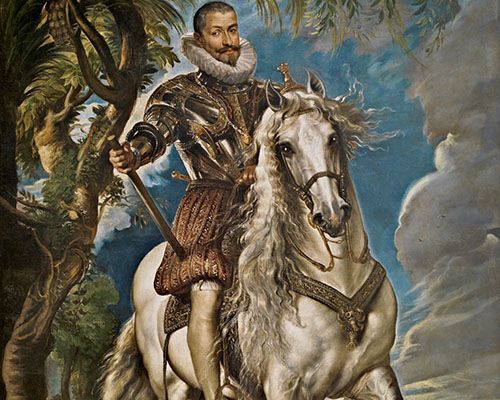
Equestrian Portrait of the Duke of Lerma
In this life-sized painting, Francisco de Sandoval y Rojas, the first minister of Spain, is shown as chief of the Spanish armies riding a white steed. He wears half armor and carries a ruler's staff. The proud Duke, adorned with the scallop of the Knights of Saint James around his neck, and his storybook-like horse are posed in the foreground looking directly at the viewer while the cavalry rides in battle in the far background.
In Rubens' earlier works, the forms were certainly robust but here each position emphasizes the powerful anatomy of the horse or rider, illustrating his knowledge of classical sculptures and their anatomical correctness. Great precision was used to depict the delicateness of the Duke's collar, intricate gleaming armor, jewelry, bejeweled garments, and spurred boots as well as the grandeur of the horse's wavy mane, bridle, intense eyes, and glossy coat. These signature Baroque elements would later make his work immortal and also included the compositional use of diagonals, muscularity (especially in the horse,) foreshortening, and the use of strong lights against darks to bring a stately drama to the scene.
Rubens' composition, which reflects his study of Titian's Portrait of Carlos V in Muhlberg, created a model for equestrian portraits of the future, especially influencing Van Dyke. As stated by Samuel Edwards in his biography, Peter Raul Rubens, the Duke of Lerma was said to be an art expert and was so impressed that "...This equestrian figure, done with great verve and dramatic boldness, was confident and spirited and is generally regarded as the first of Rubens' greatest paintings."
Oil on Canvas - Prado Museum Madrid, Spain
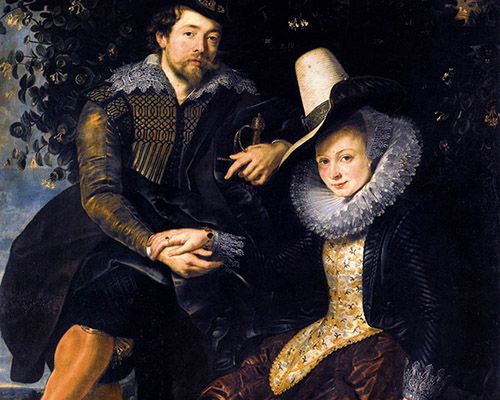
Self-Portrait with Isabella Brandt, his first wife, in the Honeysuckle Bower
In 1609, one year after returning from Italy, Rubens married Isabella Brant. The couple here are in a double self-portrait under a honeysuckle bower. About thirty-two years old, the artist presented himself dressed in chivalric elegance while Isabella, age eighteen, wears a luxurious, richly embroidered dress of heavy wine-colored taffeta silk, an enormous ruff, and a high-crowned hat. They pose here as a respected couple in Flemish middle-class life, perhaps in their inner open air courtyard where Isabella planted gardens of flowers, herbs and vegetables. Rubens designed the stone benches, brought in Classical busts on pedestals, Doric and Corinthian columns, statues, and small fountains. They are sitting in the shade, hand-in-hand, as they lean toward each other but gaze politely toward the viewer. They are surrounded by symbols of love and marriage: the honeysuckle bushes and garden are both traditional symbols of love while the holding of right hands represents union through marriage. The gentle, conservative and loving approach to the painting reflects the intimacy of the occasion.
Rubens' biographer Kristen Lohse Belkin called this piece "...one of his most delightful pictures..." She also noted that this painting is much larger, almost 5 feet by 4.5 feet, than previous portrayals of married couples with the figures shown in half-length poses.
A Baroque attention to detail is evident in the garments, jewelry, and accessories such as the crisp lace, rich glistening fabrics, the glint of the metal of the sword hilt, hatband, and jewels. These features recall the precious, jewel-like panels of earlier Flemish artists, such as Jan van Eyck and Hans Memling.
Rubens depicted himself as calm and patient which is verified by Roger de Piles' account in his book The Life of Rubens; "...he was of tall stature, of stately bearing, with a regularly shaped face, rosy cheeks, light-brown hair, eyes bright but not with restrained expression, a pleasant expression, gentle and courteous..." This same balance of "...bright but with restrained passion..." and "...intense passion moderated by energetic control..." is found in his art.
Oil on canvas on Panel - Alte Pinakothek, Rubens Room
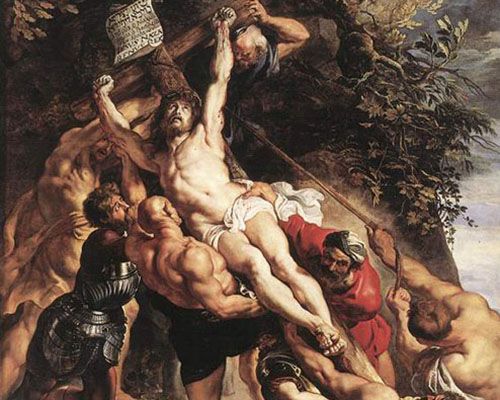
The Elevation of the Cross
Rubens was commissioned to paint his first major altarpiece in 1610 after returning to Antwerp from Italy. The painting, inspired by the biblical story from the Gospel of Matthew, depicts Christ on his Crucifix as it is being raised to the upright position. The central section presents this highly charged emotional moment while the two attached side panels display the dramatic reactions of people grieving and the two thieves who will also be crucified. The composition of the central panel presents the flurry of action and emotion surrounding the body of Christ, shown with diagonal foreshortening, amid a scene of dynamic tension. His dramatically highlighted figure is the focal point, surrounded by heavily muscled men who struggle to lift, push, and pull the heavy burden upward. Their bulging muscles indicate the physical and emotional strain they are experiencing while their expressions and eyes convey fear and disbelief.
The enormous triptych, 15 feet high by 21 feet wide, was placed above the high altar in a vast Gothic church where it would be viewed from below. The triptych format, a central painting with two hinged side panels, or wings, had been used in Northern Europe since the Middle Ages. Typically, the movable wings were painted in a less complex and subdued style illustrating less significant religious scenes or formats. Catholic reform had prompted the Church to embrace visual images for instruction as well as propaganda and no artist was suited to develop a pictorial language that would teach, convert, and arouse religious fervor more than Rubens.
The influence of Italian artists is evident in this work with the richness of the colors and a painterly technique, which recalls that of Titian whom Rubens extensively studied. The dramatic contrasts of light and dark bring Caravaggio to mind while the diagonal composition, foreshortening, muscularity, and physicality recall the work of Michelangelo. As his biographer Samuel Edwards stated: "...the finished work would be hailed as one of the most magnificent ever painted by any artist...in which suffering and fury, horror and pain and passion were expressed with such dynamic force and lyricism..."
Oil on Wood - Cathedral of Our Lady, Antwerp
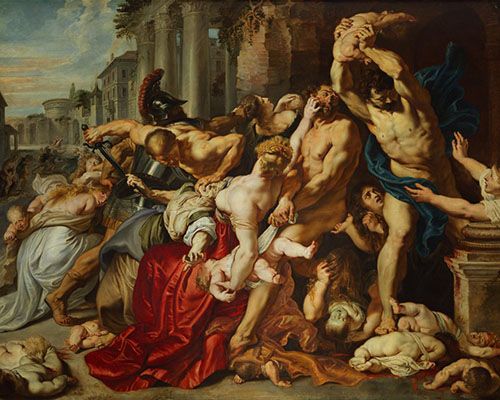
Massacre of the Innocents
This large seven by five foot painting relays a story from the Gospel of Matthew in which King Herod ordered the slaughter of all male infants in Bethlehem after he heard that a child born there would become "King of the Jews." Although the scene is horrific, it is a tremendously powerful portrayal as groups of women attempt to prevent the soldiers from killing their children. Muscular men, most of whom are quite naked, are struggling with writhing women; arms are flailing and reaching, blood is flowing as the adults fight over the children, some of whom are already trampled or dead. The frantic efforts of the mothers have no effect in stopping the gory carnage; they are a panicking, doomed group.
Rubens' intention was to shock and unnerve the public with an outcry against the atrocities of war and violence. Some years later he remarked, as quoted by Simon Schama in Rembrandt's Eyes "... We are exhausted [in Antwerp] and have endured so much that this war seems without purpose ...[and that it seemed] strange that Spain, which provides so little for the needs of this country ...has an abundance of means to wage an offensive war elsewhere."
The piece highlights the artist's influences garnered from his travels in Italy where he observed the work of Italian Baroque painters such as Caravaggio. This is seen in the use of chiaroscuro, emotive dynamism, and rich color. He also studied anatomical statues with their skin removed in order to learn even more astutely how the body was made.
Oil on Oak - The Art Gallery of Ontario, Canada

Prometheus Bound
Based on the Greek play Prometheus Bound, this classical mythological painting presents the demigod Prometheus who is being punished by Zeus for giving the secret of fire to man. He is permanently chained to a rock on Mount Caucasus while the ferocious eagle of Jupiter, a symbol of Zeus, feeds upon his liver every day.
A painting by Titian of the giant Tityus inspired the picture's dense composition, in which Prometheus tumbles downward with his left arm almost reaching beyond the canvas. The dynamic foreshortened muscular figure and the gigantic eagle with outstretched wings are the basis of the plan, beautifully detailed throughout, and set in an abstract landscape scene. The enormous bird rips open Prometheus's torso but to secure its grasp on the captive's flesh, one of the eagle's talons gouges Prometheus's right eye. His left eye is locked on the predator, clearly he is fully aware of this torture, while his writhing posture and drawn up thighs, clenched fist, and tousled hair convey his abject agony. This hulking figure, with its broad frame and dense musculature, shows the influence of Michelangelo. The masterful orchestration of heavy figures in space, the rich color palette of Italy, and the powerful eagle create an incredibly expressive work of art.
The piece, which Rubens considered one of his most important works, represents the virtuoso of the artist at his absolute height. Working in collaboration with the famed animal and still-life painter Frans Snyders, who contributed the massive eagle, Rubens rendered the brutal tale with corresponding violence. This vigorous style "...suited and expressed Rubens' temperament...straightforward demonstration of feeling and whole-hearted participation in life..." as described by his biographer Richard McLanathan.
Oil on Canvas - The Philadelphia Museum of Art, Philadelphia, PA
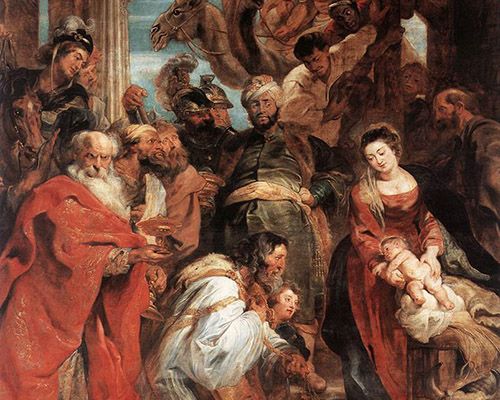
The Adoration of the Magi
This Biblical story, from the book of Matthew centers upon the Adoration of the Magi, which was one of Rubens' favorite themes; he made at least twelve paintings of this scene. In this rendition, we see the three Magi, representing the lands and races that had heard about the birth of the Savior, bearing gifts for the Christ child. The entire group faces a placid looking Mary but the central kneeling figure in white is Gaspar, who brings frankincense, and rests on a pillow before Jesus. Melchior, who brings gold, is standing behind him and the third, the Moorish King Balthasar in green with a turban, offers myrrh. The colorful group is shown crowded into the ruins of an ancient structure. On the right, the Virgin Mary, most likely modeled after Rubens' first wife Isabella Brant, looks adoringly at her happy child and presents him to the Magi. Symbols add depth of meaning to the entire scene. The ancient pillar or column symbolizes the ravaged palace of David from whose bloodline the Messiah was born. The peaceful ox is a symbol of faith and the tiny spider in the web, top right, symbolizes the evil, which Jesus will overcome.
The enormous painting, almost 15 by 11 feet, would be overwhelming to view without the artist's careful planning utilizing signature Baroque techniques. Rubens' brushwork keeps the energy flowing around the many figures honoring Jesus including servants, soldiers, horses, camels, and one ox all blended into a cohesive whole by Rubens' masterful use of diagonals, color, light, and the careful placement of forms. The bright reds and glowing light areas of the exaggerated faces, the hair, beards, and the clothing also guide the viewer's eyes.
The piece remains an important signifier of the times, representing the humbling of the world before the Church.
Oil on Panel - Royal Museum of Fine Arts, Antwerp
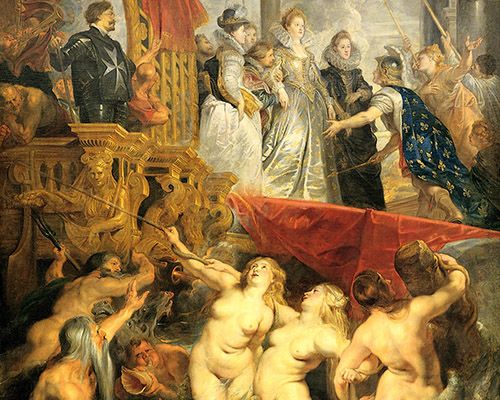
The Disembarkation at Marseilles
In this painting, we see Madame de' Medici, arriving to marry the French King Henry IV, ready to leave her ship via a decorated gangplank amid trumpets. The spectacle is overseen by an angel aloft, a symbol of Fame, Poseidon, the sea god, with three of his daughters, and Neptune calming the waves. To the left, the arms of the Medici, a symbol of Marie's heritage, can be seen placed above the golden arched structure behind a Knight of Malta, the only immobile figure, in full regalia. Accompanied by her ladies in waiting, the Queen Mother is welcomed by a personified France wearing a helmet and the royal blue mantle with golden fleur-de-lis, the national symbol as the sea and the sky rejoice. Rubens presented, to the court and subsequent generations, a visual celebration of responsible and just rule.
Paris was the largest metropolitan center in Europe when the young Marie de' Medici granted Rubens a royal audience to discuss a series of 24 paintings for the gallery of the new Luxembourg Palace which would depict her personal struggles and triumphs in life. Rubens was eager to try a secular theme and in this painting he turned the ordinary task of arriving from Italy in Marseilles into a scene of magnificence. He employed the extensive use of symbols, allegories learned in his early training, classical literature and customs in these works.
The composition of the large narrative scene, 13 feet by almost 10 feet, is based on diagonals, the placement of the figures and objects, as well as on the careful use of color and light. The golden ship intersects with the decorated gangplank to create the space for the departing guests. The rich red cloth draped over the arched structure and the plank help to draw our eyes in to find the Queen.
The Abbe de St.-Ambroise, an influential French art critic of the seventeenth century, praised Rubens for taking on the series of paintings by remarking "...No one else in all of Europe could have brought such a vast work to a successful conclusion. The Italians would take more than ten years...you are unique...you stand high above every other artist now alive in the world, and your paintings for Marie de' Medici will be immortal."
Oil on Canvas - Musée du Louvre, Paris
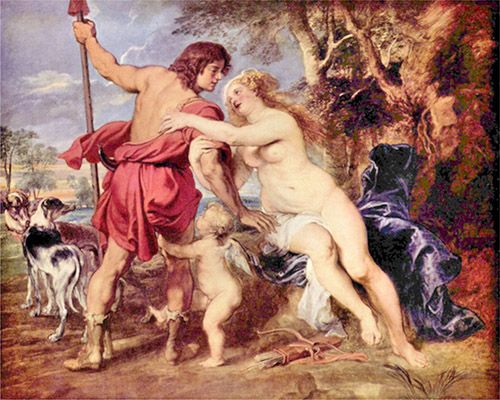
Venus and Adonis
The painting tells a story from Ovid's Metamorphoses. The myth relates the sad tale of Venus, who, having been grazed by one of Cupid's arrows, falls helplessly in love with the handsome mortal hunter, Adonis. The nude Venus is seated gracefully, leaning into the center of the composition as she implores the muscular Adonis to stay. She gently pulls him toward her with a beseeching expression while a small Cupid, the god of love, tugs his right leg to keep him safe. The sensuous goddess is adorned with one glossy pearl teardrop earring and two small pieces of cloth. The muscular Adonis, the incarnation of a Greek sculpture, is clothed in a vibrant red tunic, his body standing out against the light blue sky. The poses of the two figures bring them together as one large central triangle that sits solidly in the middle of the composition. Within this triangular space, all movement of arms, clothing and expressions are gentle, soft and loving. A large sinewy tree with wispy leaves to the right and the sky are painted as a gentle backdrop to the tender emotional scene.
Artists and poets were, and continue to be, fond of this tragic love story, and Rubens was familiar with, and drew upon, Titian's painting of the theme. It's interesting to note that Venus bears a resemblance to, and was probably modeled nude by, the artist's second wife Helena Fourment.
Although Rubens was a devout Roman Catholic, his religious paintings were not influenced by the strict formality of his era. He instilled a lusty exuberance into his paintings rather than adhering strictly to academic, traditional forms. This painting was completed in the last decade of his life at a time when he struggled with severe arthritis almost daily yet it displays the rich colors, superb technical ability, and vitality of his best work. As Rubens told his friend Peiresc in a letter from 1635 and as quoted in Rubens and the Roman Circle: "...I was not yet inclined to live the life of a celibate...I have taken a young wife of honest but middle-class family although everyone tried to persuade me to make a court marriage... I chose one who would not blush to see me take my brushes in hand. And to tell the truth it would have been hard for me to exchange the priceless treasure of liberty for the embraces of an old woman."
Oil on Canvas - The Metropolitan Museum of Art, New York City, New York
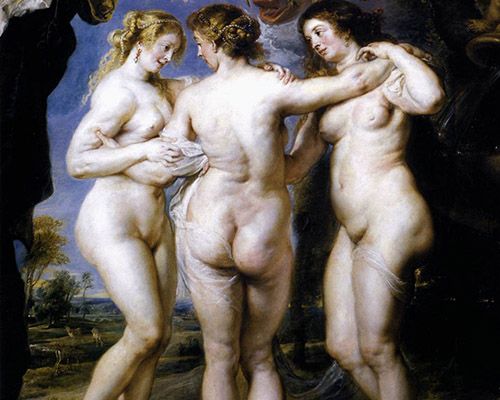
The Three Graces
This story from Greek mythology presents The Caritas, or Three Graces, who were divinities and daughters of Zeus. Their names were Aglaia, which stands for radiance, Euphrosin, which means joy, and Thalia, meaning to flower. They were pure virgins who served Aphrodite and worked at banquets to foster the joy of life. The three figures form a circle, linked by their arms, one with her back to the viewer. These ladies were the goddesses of pleasant charm, charitable deeds, and gratitude who gave people the qualities of friendliness, strong character, sweetness, and fine conversation. The elegant grouping seems to radiate light, as three beautiful virgins seem to glow, even though they have little clothing beyond transparent draping. A tree on the left, a golden cornucopia, from which water is flowing, and a floral garland above all frame the women. They are set in a subtle, picturesque landscape with a bright blue sky and animals grazing in the background.
Rubens had painted this trio several times since 1620 but here he employs the classical techniques from ancient Greece. Most likely, Rubens' wife Helen Fourment posed for him to bring out the sensual beauty, but the poses were based on classical Greek sculpture. Rubens' mastery of painting flesh tones is also apparent in this trio. He used the three primary colors of yellow, red and blue, which comprise the appearance of everything in the world.
In the last ten years of his life, Rubens painted mythological works which were his "...hymns to the beauty of women...placed in magnificent landscapes..." as described by Frans Baudouin in his biography P. P. Rubens. His signature mastery of the nude female form would catapult him into universal recognition, garnering his figures the term "Rubenesque," which is still used widely today to describe voluptuous women.
Oil on Oak Table - Prado, Madrid, Spain

Return of the Peasants
The subject of the painting is a summer landscape, a warm sunlit bucolic scene with peasant farmers returning from work in the fields in the late afternoon. Their general direction is left to right along a curving lane where one man on horseback is pulling a rustic cart. Dogs run ahead of him to urge the sheep toward home. The women carry bales of hay while horses and cows graze peacefully in the background. The setting sun makes the shadows grow longer and the streaming clouds overhead are darkening. Rubens has one woman on the far right gaze out at us to make a human connection.
The composition utilizes the horizon line sloping across the center to provide the viewer with a "bird's eye view" of the countryside around Malines in the province of Antwerp. A series of brushy diagonals pull the eye back into the space: the line of trees on the right side, the horse, rider and cart, the women's long sticks, the running sheep, the various rocky structures in the lyric landscape, and the cloud formations. Even the two birds contribute to the amount of movement in the sky. The colors are muted and rich to reflect the artist's sense of a tranquil, quiet majestic rural scene.
Rubens was inspired by Pieter Bruegel the Elder's country landscapes of the sixteenth century but his main interest was the epic grandeur of nature rather than the everyday activities of the peasant workers. He also recognized an aspect of landscape that he had admired in Titian's work: the interrelationship between the figures and the world around them.
Ruben's own earthly paradise was the countryside to which he brought this understanding from Titian. In 1635, he bought a country estate, The Chateau de Steen, south of Antwerp, where he spent much of his time, leaving his hectic life of the workshop for a more peaceful and prosperous atmosphere. Rubens looked at nature in a new way in the country, observing the natural phenomena of local flora, the effect of light, reflections on the water and all small details. He began a series of drawings outdoors to use inside the studio for reference. Every aspect of his work became less orderly and compartmentalized; ancient myths became a vehicle for representing everyday human joys and tragedies. The art became more human: joyous, sad, humorous, moving, violent and tender.
Oil on Wood - Palatine Gallery, Florence
Biography of Peter Paul Rubens
Childhood and Education
Peter Paul Rubens was one of six children born into a working-class family of tanners, lawyers, and burgesses in Antwerp, the busiest and richest seaport in Europe at the time. His father Jan Rubens, a lawyer and alderman, was involved in politics and other social affairs while his mother Maria Pypelinckx was an heiress and writer from the Southern Netherlands. He was named for the Solemnity of Saints Peter and Paul, the liturgical feast in honor of the ancient martyrdom in Rome, which occurs on June 29.
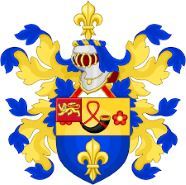
In 1589, Antwerp was deeply affected by religious strife and wars. Peter Paul was raised in his mother's faith of Roman Catholicism and educated according to the humanist traditions, which included the study of Latin and classical literature. He attended school in Cologne where he surpassed all his fellow students as his father had instilled a lasting love of learning in his boys.
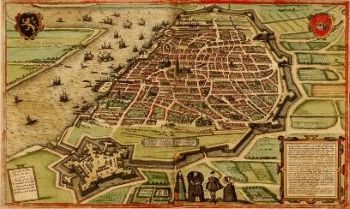
Peter Paul's life at court began as messenger to a noblewoman and widow. This was not a position that Peter Paul would have chosen, since painting was a stronger calling, but his mother desired to make her son a courtier due to his naturally diplomatic personality. Therefore, although "...the father dies when his son Paul was ten, the handsome, intelligent boy became a court page but was already drawing ...His happy view of the world, his love of the human figure and well-set table, gave Peter Paul Rubens a taste for the good life. He showed it in his portfolio of drawings celebrating women, horses, the play of gods and goddesses, the fruitful fields, the peasants dancing, the filled, smoking stables, the feel of silk and furs, armor and marble, marked out by his magic lines..." explained Stephen Longstreet in the introduction to his book The Drawings of Rubens (1964). These young experiences of courtly life and noble and royal circles were useful later in life since the young Rubens gained confidence and knowledge of the required social protocol to associate with aristocratic and royal patrons.
Early Period
At age 13, Peter Paul and his 16-year-old brother Philip were obligated to find more lucrative work to support their family after the death of their father and the costly marriage of their sister Blandina. In 1591, at age 14, Rubens was apprenticed to Tobias Verhaeght, a distant relative and uninspired landscape painter of little renown, in Antwerp. After one year, he began working in the studio of Adam van Noort, a more talented figure painter and popular master among the students, where he remained for four years. Then, he was made senior apprentice to Antwerp's most accomplished artist, Otto van Veen, foremost among the city's history painters. By 1598, at age 21, Peter Paul qualified as an independent master artist with the Guild. He could speak Latin, Greek, French, and Italian as well as the Flemish and Spanish of his native home. Within three years, he was made a franc-maitre of the Guild of St. Luke, which was the requirement for any artist to engage apprentices or sell paintings to the public. The guild was made up of lively artists, printers, ceramic makers, type designers, and goldsmiths who provided contacts for each other from all areas of society.
In May 1600, Rubens traveled to Italy where he first visited Venice to see the paintings of Titian, Veronese, and Tintoretto. He was immediately influenced by the rich colors and dramatic compositions. In Venice, he also met a gentleman who worked for the Duke of Mantua, Vincenzo Gonzaga, who was so impressed with Rubens' amiable, sober, and self-disciplined character that he recommended him to the Duke, who was "...a man very fond of luxury, painting and all the liberal arts..." as explained by Kristin Lohse Belkin in her book, Rubens. Rubens became court painter to the Duke, who supported him financially with travels to Rome and Spain to study classical art, paint his own masterpieces, and make copies of the Italian master paintings including those of Michelangelo, Raphael, Leonardo da Vinci, and Caravaggio. Rubens himself wrote many years later, "I served the Gonzaga family for many years, and while I was young the delights of a stay in that part of Italy were very much to my liking."
Mature Period
Rubens also recommended worthy purchases of art to the Duke and performed diplomatic missions until he returned to Italy in 1604. He and his brother Philip rented an apartment with a studio, hired servants, and enjoyed entertaining their friends with whom they discussed their work. On a second visit to Rome, Rubens studied the ancient Greek and Roman sculptures, and further explored the masters of the Renaissance. His own advice exists in the only surviving piece of his theoretical writing from a now lost notebook: "...I am convinced that in order to achieve the highest perfection one needs a full understanding of the statues, indeed a complete absorption in them; but one must make judicious use of them and before all avoid the effect of stone...". He painted many portraits during this period that influenced later artists such as Anthony van Dyck, Joshua Reynolds, and Thomas Gainsborough.
In October 1608, Rubens left Rome abruptly after learning that his mother was seriously ill but by the time he reached her, she had passed away. He decided to remain in Antwerp and in September 1609 became the court painter for the Archduke Albert and Archduchess Isabella in Brussels. Soon after, Peter Paul fell in love with Isabella Brant, the eighteen-year-old niece, of his brother's wife. Rubens and the charming and intelligent Isabella lived with her family while he had a new house built for them, now named the Rubenshuis Museum, which was finished by 1615. This Italian-influenced villa in the center of Antwerp accommodated his workshop, where he and his apprentices worked, along with his personal art collection and library, both of which were among the most extensive in the city.
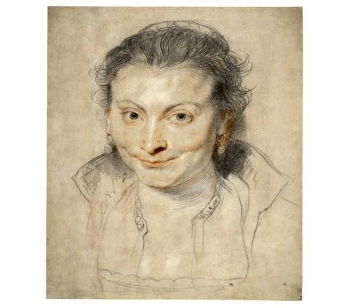
During this time, Rubens grew his studio to encompass numerous students and assistants, the most famous of whom was the young Anthony van Dyck, soon to become the leading Flemish portraitist. He also often collaborated with the many specialists active in the city, including the animal painter Frans Snyders, who contributed the eagle to his masterpiece Prometheus Bound, and his good friend, the flower-painter Jan Brueghel the Elder.
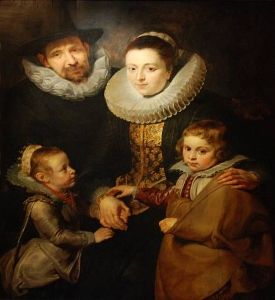
During the decade 1610 to 1620, the Rubens' studio produced an enormous amount of altarpieces for the Roman Catholic churches. Rubens felt compelled to blend Flemish realism with the power and fire of Michelangelo while utilizing color like Titian. Many paintings based on secular scenes of mythology, history, allegory, portraits, landscape, and hunting were also created, of which Rubens personally painted the most important people and sections. Rubens scholar Kristin Lohse Belkin noted that the Danish court physician Otto Sperling observed the process during a visit to Rubens' studio in 1621 as "...a good number of painters each occupied on a different work, for which Mr. Rubens had provided chalk drawings with touches of color added here and there. The young men had to work these up fully in paint, until finally Mr. Rubens would add the last touches with the brush and colors. All this is considered a Rubens' work; thus he gained a large fortune, and kings and princes have reaped gifts and jewels upon him." Rubens claimed to be "...by natural instinct, better fitted to execute very large works than small curiosities." This particular strength and talent played a very important role in his career as his focus shifted from Antwerp to the royal European courts.
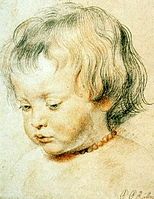
Between 1627 and 1630, Rubens' diplomatic career was in full swing as he moved between the courts of England and Spain in an attempt to bring peace between the two countries. A more private reason for the traveling was that his wife Isabella had died in the summer of 1626, probably due to the plague, and he desired a change of surroundings. As the artist said, according to Kristin Lohse Belkin "...I should think a journey would be advisable, to take me away from the many things which necessarily renew my sorrow...The novelties which present themselves to the eye in a change of country occupy the imagination and leave no room for a relapse into grief."
Unfortunately, these diplomatic meetings had little political consequence. Nevertheless, Rubens was greatly appreciated. He was knighted by Charles I of England, Philip IV of Spain, and awarded an honorary Master of Arts Degree from Cambridge in 1629. He resumed his study of the paintings of Titian; it has been said that Rubens copied every Titian in King Philip's collection. He also befriended the 29-year-old, soon to be infamous, court painter Diego Velázquez.
Late Period and Death
Rubens last decade was spent freely pursuing the most interesting commissions and his own artistic inspirations in and around Antwerp. In 1630, at the age of 53 years, he married his first wife Isabella's niece, the beautiful 16-year-old Helene Fourment, whom he also used as his model in many of his paintings.
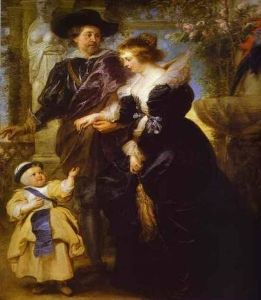
During these final ten years, Helene bore Rubens five children. Plagued by gout or arthritis, Rubens' body had become frail yet he continued to work. He wrote to his friend in 1634, "...Today I am so overburdened with the preparations for the triumphal entry of the Cardinal-Infante, that I have time neither to live or to write... I believe you would not be displeased at the invention and variety of subjects, the novelty of designs and the fitness of their application." In 1635, he bought a country estate near Antwerp, Het Steen in Elewijt, where he painted primarily landscapes of a countryside filled with humans in harmony with nature. He died in May 1640 and his remains were buried in the Jacobskerk in Antwerp.
A quotation from Juvenal, the Roman poet of The Satires, was carved in stone over the entrance to Rubens' garden. As Samuel Edwards explained, it was an apt description of Rubens' hearty and well-lived life: "...Let us leave to the gods the care of dispensing their benefits to us and of giving us what we most need. They love men better than men love themselves. Let us ask them only for health of body and soundness of mind, for a strong soul free from the fear of death and untouched by anger or vain desires."
The Legacy of Peter Paul Rubens
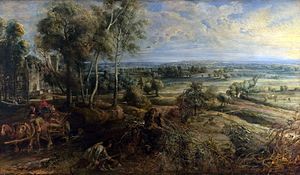
His profound stylistic influence would span over three centuries from van Dyck to the Impressionist Renoir. In Italy, he influenced Baroque painters Pietro da Cortona and Luca Giordano. In Spain, he befriended and influenced Velazquez and in England, Thomas Gainsborough and Sir Joshua Reynolds. The 19th century French Romantic painter Eugene Delacroix wrote that Rubens "...carries one beyond the limit scarcely attained by the most eminent painters; he dominates one, he overpowers one, with all his liberty and boldness."
As stated by his biographer, Samuel Edwards, "...he is known to have produced more than three thousand works of art, doing all or the principal portion of each himself..."
Influences and Connections

- Balthasar Moretus
- Nicholas-Claude Fabri de Peresc
- Anabale Chieppio
- Duke Gonzaga
-
![Diego Velázquez]() Diego Velázquez
Diego Velázquez - Jan Brueghel the Elder
- King Charles I of England
Useful Resources on Peter Paul Rubens
- The Drawings of Rubens' (Master Draughtsman Series)By Stephen Longstreet
- RubensOur PickBy Kristin Lohse Belkin
- First Impressions: Peter Paul RubensBy Richard McLanahan
- RubensBy Frans Baudouin
- The Letters of Peter Paul RubensBy Ruth Saunders Magurn
- Rubens: A Master in the Making (National Gallery London Productions)By David Jaffe
- Peter Paul Rubens: A Biography of a GiantBy Samuel Edwards














